50+ Sample Weekly Schedules
-
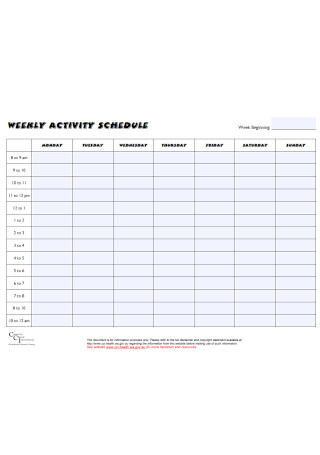
Weekly Activity Schedule
download now -

Weekly Schedule Format
download now -

Weekly Study Schedule Template
download now -

Weekly Time Management Schedule
download now -

Weekly Study Leave Schedule
download now -

Weekly Schedule Planner Template
download now -

Sample Weekly Schedule Template
download now -

Weekly Planning Schedule Template
download now -

Weekly Management Schedule
download now -

Weekly Schedule Planner
download now -

Study Weekly Schedule Template
download now -

Master Weekly Schedule
download now -

Basic Weekly Schedule Template
download now -
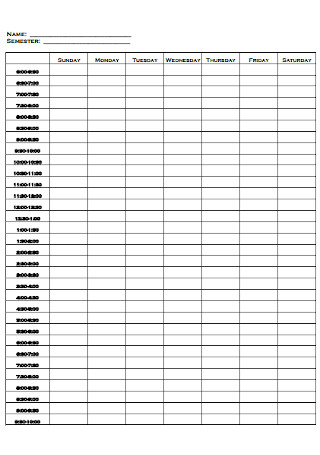
Weekly Semester Schedule Template
download now -
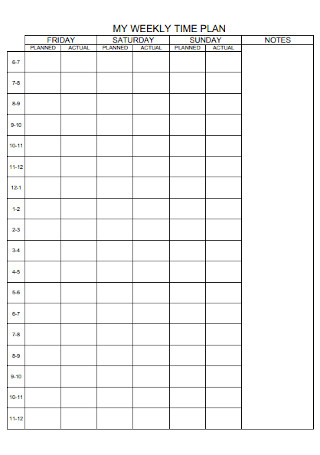
Weekly Time Plan Schedule
download now -

Academic Weekly Schedule
download now -

Weekly Schedule Planning Worksheet
download now -

Student Weekly Schedule Template
download now -

Altered Weekly Schedule
download now -

Weekly Payroll Schedule Template
download now -

Simple Weekly Schedule Template
download now -

Formal Weekly Schedule Template
download now -

Master Weekly Schedule Template
download now -

My Weekly Schedule Template
download now -

Weekly Schedule Format
download now -

Upper School Weekly Schedule
download now -

Weekly Schedule Form
download now -

Year Weekly Schedule Template
download now -

Weekly Learning Schedule Template
download now -

Weekly Class Schedule Template
download now -

Semester Weekly Schedule Template
download now -

University Weekly Schedule Template
download now -

Weekly Schedule of Online Classes
download now -

Weekly Maths Schedule Template
download now -

Weekly Advisement Planner Schedule
download now -

Sample Weekly Schedule Example
download now -

Schedules for Weekly Support Payments
download now -

Weekly Work Schedule Template
download now -
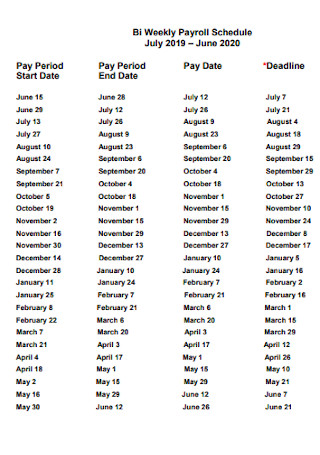
Weekly Payroll Schedule Template
download now -

Weekly Calendar Schedule Template
download now -

School Weekly Schedule
download now -
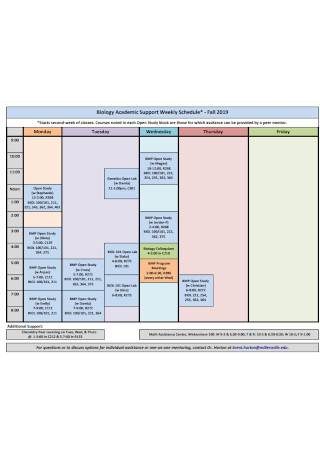
Academic Support Weekly Schedule
download now -

Host Teacher Weekly Schedule
download now -

Weekly Schedule for Behavioral Activation
download now -
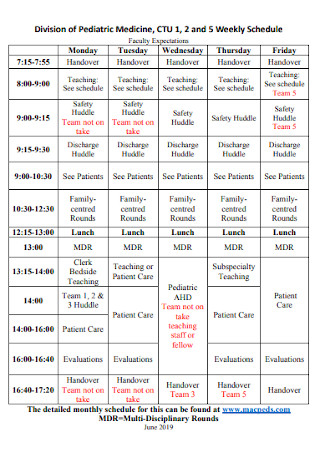
Weekly Medicine Schedule
download now -
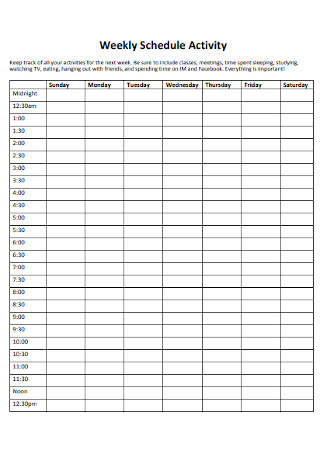
Weekly Schedule Activity Template
download now -

Student Weekly Schedule Example
download now -

Weekly Schedule for Site Based Coach
download now -

Temporary Contract and Weekly Schedule
download now -

Visual Weekly Schedule Template
download now
FREE Weekly Schedule s to Download
50+ Sample Weekly Schedules
What Are Weekly Schedules?
Smart Weekly Schedule Strategies
The Main Parts of a Weekly Schedule
How to Make a Proper Weekly Schedule
FAQs
What is the difference between a weekly schedule and a weekly plan?
What are the different types of scheduling?
What is the most standard scheduling method?
What Are Weekly Schedules?
A weekly schedule is quite self-explanatory—a detailed schedule that covers every task or activity to be done in a week. Similar to a weekly plan, the weekly schedule outlines what you must do and when to actually do them in a 7-day period. So if you need a quick and informative reminder about your list of activities along with its corresponding time from Monday to Sunday, you can always depend on weekly schedules.
Did you know that it takes an average of 23 minutes and 15 seconds before you may resume your task?
Why Is a Weekly Schedule Essential?
Weekly schedules are important so you won’t miss doing every necessary task you have laid out for a week. Forgetfulness is a common issue for some people that they end up not completing their responsibilities on a weekly basis. And besides being forgetful, a weekly schedule is also beneficial to combat procrastination. The problem with some people is they don’t continue their tasks as planned due to being lazy. In fact, Lifehacker’s research survey reported that it takes around 23 minutes and 15 seconds before you might resume your task. Hence, don’t be distracted and stick to your planned weekly schedule.
Smart Weekly Schedule Strategies
Yes, you already know what a weekly schedule is for. But some people somehow fail in sticking to the plan. It might have something to do with your lack of a strategic plan to ensure the weekly schedule is well-made. Take a look at these smart strategies worth implementing for your next weekly schedule:
The Main Parts of a Weekly Schedule
Since you already have an idea of how to strategize the weekly schedule, how about what a weekly schedule looks like? It is known that besides the title ‘Weekly Schedule,’ there are other significant parts that should be included in the schedule. And they consist of the following:
Date and Time
It is only fit for weekly schedules to have the complete date and time. Expect to note down the needed elements of a weekly calendar. For example, you add a table with columns dividing Sunday to Saturday. And you insert rows dividing the different hours and minutes per day.
Task List
One of the most important components of the weekly schedule is the task list. This list contains all the duties or responsibilities that you must accomplish for a week. The reason you need a weekly schedule in the first place is to achieve your necessary tasks. Thus, list them individually until you slowly complete them.
Progress Checker
You might forget about which tasks were already done or still in progress. Hence, incorporate a progress checker into your schedule. You can work on it similar to a to-do list or checklist where checkmarks are provided to every finished activity. That way, you can easily see from your schedule if you have accomplished everything or not yet.
Notes
To be flexible with your weekly schedule, insert a blank space for possible additional notes. You can write anything in this free space may it be for additional tasks, a change of plan, and other notes worth observing for your weekly schedule.
How to Make a Proper Weekly Schedule
Now for the main course of the event, are you ready to create your own weekly schedule? Bear in mind that there is no single format or content for weekly schedules because people vary in terms of their goals, objectives, preferences, and lists of activities. But if you want to create weekly schedules in the easiest and most proper way, you may apply the following steps:
Step 1: Identify Your Intention or Purpose
Yes, you need a weekly schedule. But what is your purpose behind needing it? Weekly schedules may involve varying intentions. For example, is it for your work schedule, school schedule, or just a personal schedule? Remember that what works for your weekly family schedule might be irrelevant for a work schedule. House cleaning duties won’t apply to the workplace anyway. So be sure to stick to your purpose so you’ll know how to tailor it.
Step 2: Start Brainstorming Your List of Activities
If you used to have a daily planner, then you would know that brainstorming is part of the process to identify what your responsibilities and plans are. The same goes for your weekly schedule wherein you list all the activities needed to finish for the whole week. Brainstorming is essential so you won’t miss out on each responsibility that might have been absent on your final weekly schedule. This part is also where you decide what to add or subtract from your task list.
Step 3: Associate the List with a Weekly Calendar
Now that you have your set of task lists, don’t forget to include the date and time to associate with them. Incorporating a weekly calendar into the schedule is how this plays out. So from every activity mentioned earlier, when is the actual time or date to do them? Answer it individually by estimating the time, duration, etc. And you will have the smart weekly schedule strategies discussed earlier as your guide on how to ace this step.
Step 4: Insert the Basic Parts of a Weekly Schedule
Besides the date and time, you already know that there are other important parts of a weekly schedule, as discussed earlier. Hence, don’t forget the notes, progress checker, and so forth. You will slowly complete your schedule when every part is inserted. And the best part is you can always customize your schedule. Decide whether you want printed copies or soft copies. Or perhaps, you edit by arranging your details according to what seems easier for you to follow. An easy-to-use structure is highly recommended.
Step 5: Organize Your Schedule
Maybe your schedule seems ineffective because of poor organization. Just like any other document, you should produce a well-organized output. Hard-to-follow weekly schedules might only confuse you in completing tasks. The key is to be direct wherein your instructions are easily understood. At the end of the day, whoever uses the schedule should find the instructions, content, and details in the schedule convenient.
Step 6: Stick to the Plan and Be Flexible
Even when you can come up with a well-written weekly schedule, the main flaw might come from your willingness to stick to the schedule. Follow the obvious plan which is to accomplish all your tasks in a week. But if there are distractions, emergencies, and possible changes, be sure to adjust flexibly. That is why you have the notes section to add extra instructions if needed.
FAQs
What is the difference between a weekly schedule and a weekly plan?
Indeed, a weekly schedule and a weekly plan are similar in a way that they enlist all the activities to be done in a week. But their difference is that a weekly schedule is more concerned about what time and date the tasks to be done in the week are. In a weekly plan, scheduling isn’t that much of a concern as long as the tasks are finished in one week.
What are the different types of scheduling?
It is known that there are five basic types of scheduling. And they are time-slot scheduling, wave scheduling, open appointment, wave and walk-in appointment, and double booking.
What is the most standard scheduling method?
The CPM or the critical path method is a common scheduling method often used in construction businesses. And this technique has helped predecessors and even successors for how many years to ensure every construction-driven task or job, in general, is achieved.
If you used to have a hard time dealing with tasks and time management on a weekly basis, then it’s time to find the perfect medium to keep you productive and organized. Check out sample weekly schedules that are professionally premade so you have a guide on how to ace weekly planning in the most flexible tool possible. Each sample weekly schedule is ready to customize, print, and download. Start scheduling like a pro now!
